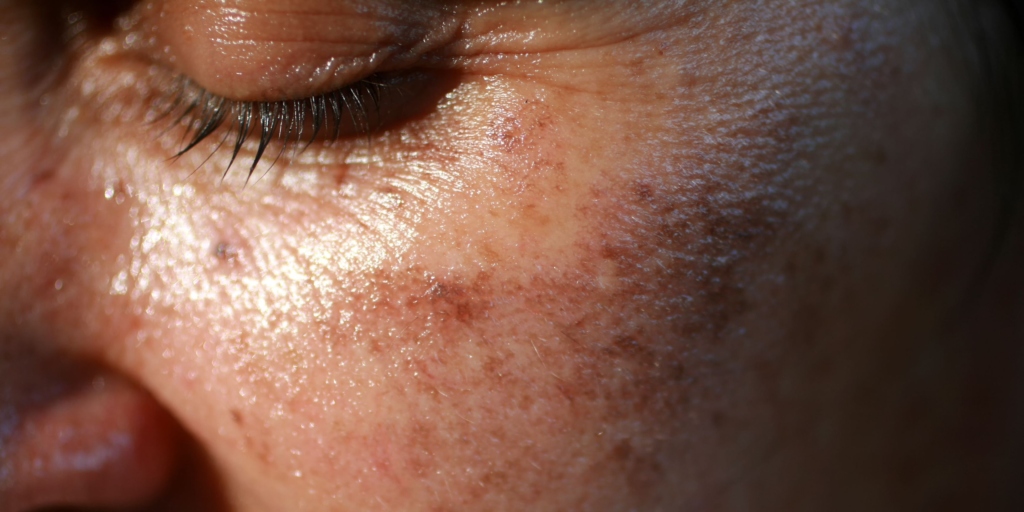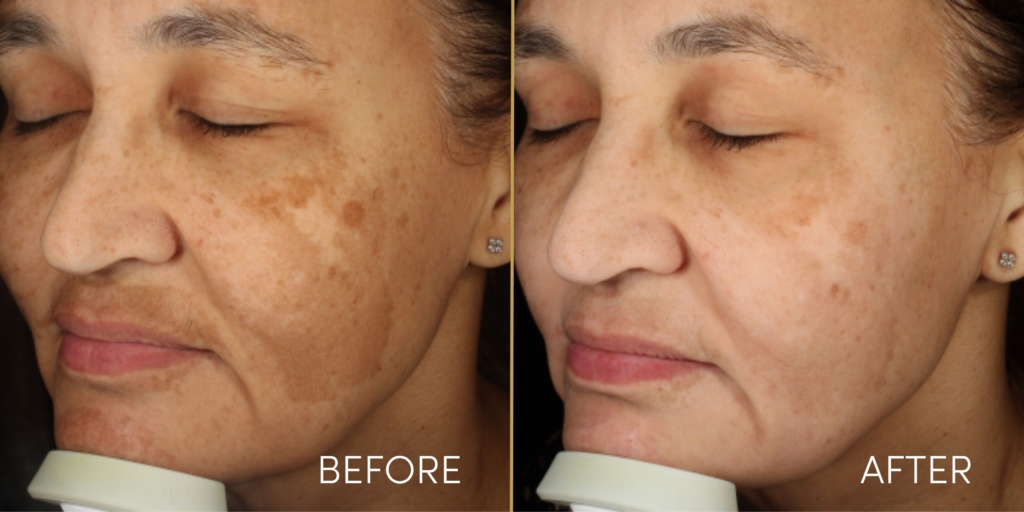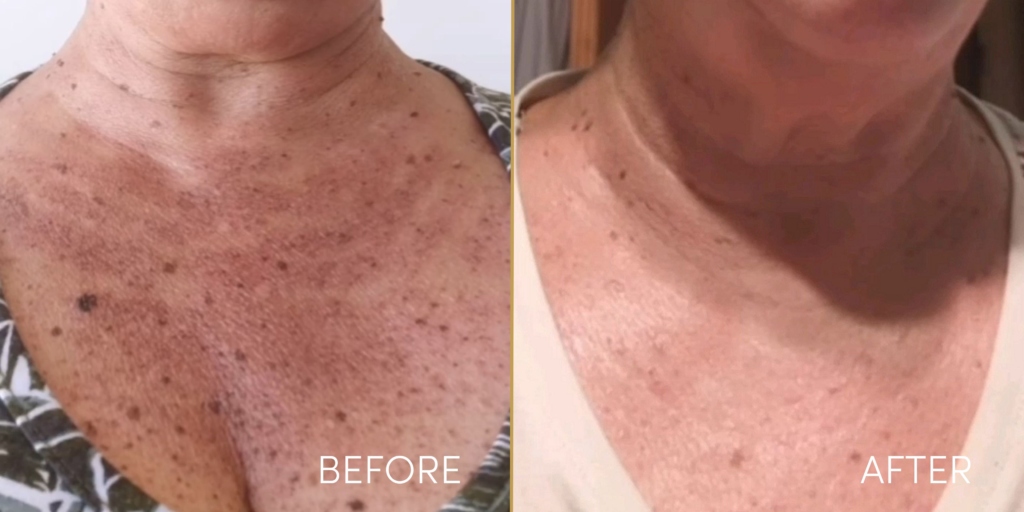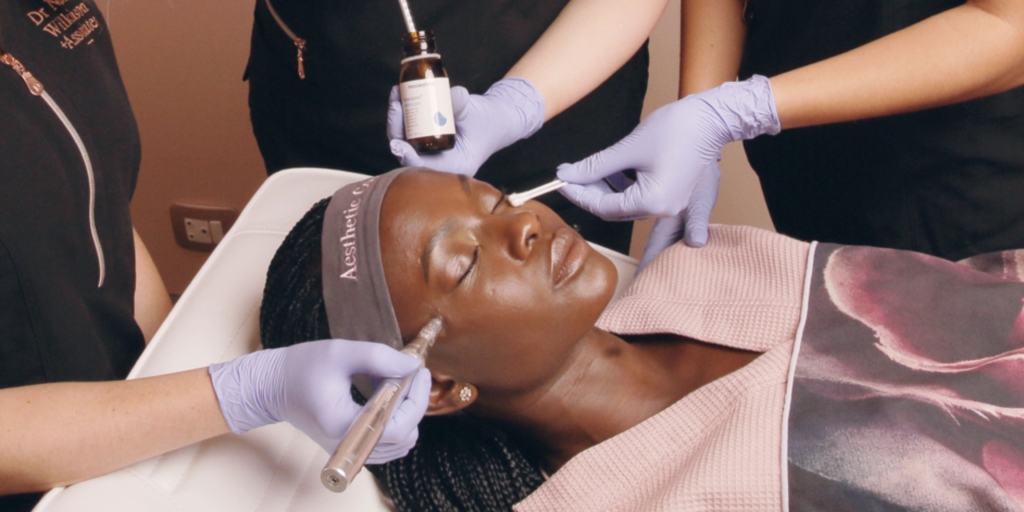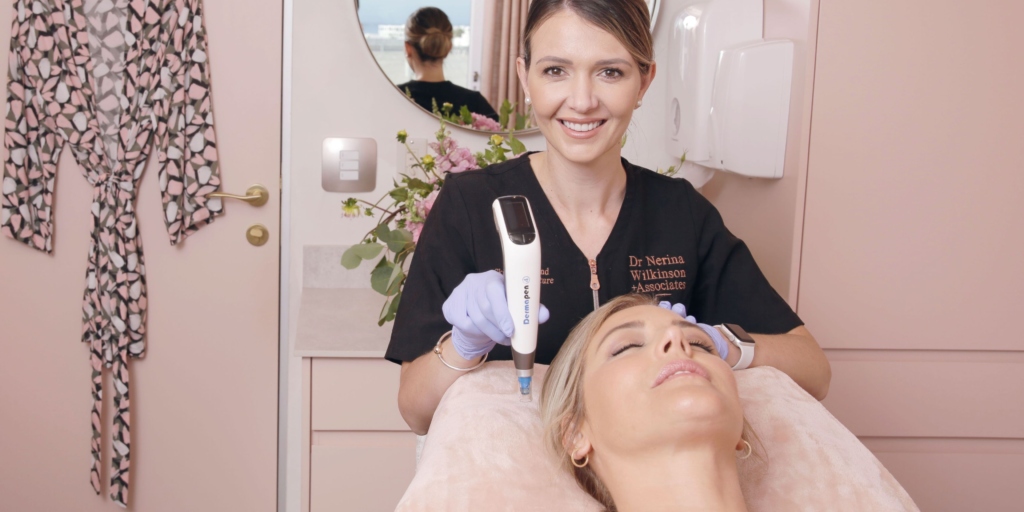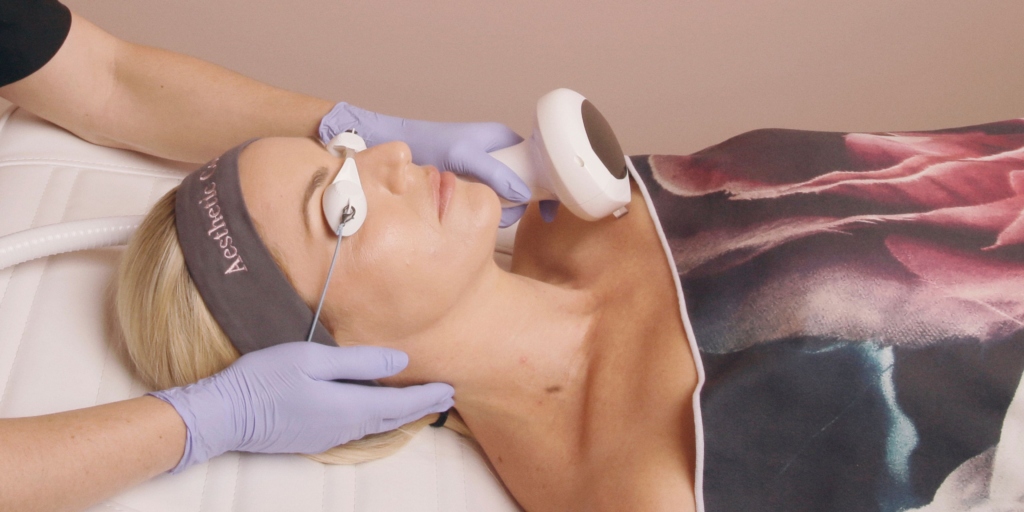by Senior Skincare Specialist, Kim van Zyl
Welcome to our dedicated space on pigmentation, where we embark on a fascinating journey through the evolution of pigmentation treatments and the groundbreaking scientific discoveries that have paved the way.
In this blog, we will unfold the spectrum of modern treatments that have transformed skin care, from the precision of laser therapies to the innovative approaches of microneedling techniques, and the rejuvenating effects of chemical peels, among others. Our goal is to offer a comprehensive overview, shedding light on how these treatments work, their benefits, and the scientific principles behind them.
Take a moment and join us in exploring cutting-edge skin pigmentation treatments and the latest scientific research, promising a world where beauty and science converge to reveal the best in skin health and aesthetics.
Table of contents
- WHAT ARE PIGMENTATION DISORDERS?
- CAUSES OF PIGMENTATION DISORDERS
- BIOLOGICAL MECHANISMS BEHIND PIGMENTATION
- PHYSICAL AND EMOTIONAL IMPACT OF HYPERPIGMENTATION
- TREATMENTS FOR PIGMENTATION DISORDERS
- LATEST RESEARCH AND ADVANCEMENTS IN DEPIGMENTATION TREATMENTS
- THE FUTURE OF DEPIGMENTATION
- PERSONALISED DEPIGMENTATION
- WHERE TO START
WHAT ARE PIGMENTATION DISORDERS?
Pigmentation disorders are a fascinating yet challenging realm of skincare, affecting the skin’s natural colour and resulting in an array of conditions that can alter one’s appearance. At the heart of these conditions is melanin, the pigment responsible for skin, hair, and eye colour. Pigmentation disorders arise when the body produces too much or too little melanin, leading to hyperpigmentation (dark spots or patches) or hypopigmentation (light spots or patches), respectively. Such imbalances in melanin production can cause not only aesthetic concerns but also emotional and psychological distress for those affected.
These disorders manifest in various forms, including melasma, characterised by dark, often symmetrical patches on the face; post-inflammatory hyperpigmentation, which occurs following skin injury or inflammation; vitiligo, notable for white patches that emerge due to the loss of pigment-producing cells; and solar lentigines, commonly known as sunspots, triggered by excessive sun exposure. Each condition presents a unique challenge in diagnosis and treatment, highlighting the importance of understanding the underlying causes and mechanisms.
By delving into the complexities of pigmentation disorders, we begin to appreciate the intricate interplay between genetics, environmental factors, and skin health, setting the stage for targeted and effective treatments. the causes and treatments of these conditions are as varied as the disorders themselves, encompassing a range of genetic, environmental, and lifestyle factors.
CAUSES OF PIGMENTATION DISORDERS
Most pigmentation disorders develop over time and can be due to a variety of reasons. Think of sunspots on the hands that “all of a sudden” became visible in your 40s, or the “pregnancy mask” that appeared shortly after you first received the good news. What about that dark spot that formed on your forehead after you accidentally burned yourself with the hair straightener or the excessive freckles that appeared years after your last beach break in Greece? Let’s look at some of the most common causes of pigmentation disorders:
Genetic Factors: Conditions like albinism or vitiligo are often inherited and result from mutations in genes responsible for skin coloration.
Hormonal Changes: Melasma, characterized by dark, discoloured patches on the skin, is often triggered by hormonal changes, such as those occurring during pregnancy or due to birth control.
Inflammation: Post-inflammatory hyperpigmentation (PIH) occurs after an inflammatory skin condition, such as acne or eczema, has healed, leaving dark spots behind.
Sun Exposure: Prolonged or excessive exposure to UV radiation can lead to sunspots or solar lentigines, a form of hyperpigmentation.
BIOLOGICAL MECHANISMS BEHIND PIGMENTATION
Pigmentation disorders encompass a spectrum of conditions altering skin colour, resulting in dark spots, patches, or uneven tones. These deviations stem from melanin imbalances, the pigment dictating skin, hair, and eye hues. Factors like genetics, sun exposure, hormones, and medications disrupt melanin production, yielding conditions such as hyperpigmentation, melasma, vitiligo, and post-inflammatory hyperpigmentation.
Mechanistically, melanin production and distribution are central. Melanocytes generate melanin, pivotal in determining skin tone. Disruption of melanocytes leads to either excessive or deficient melanin, manifesting as hyperpigmentation or vitiligo, respectively.
PHYSICAL AND EMOTIONAL IMPACT OF HYPERPIGMENTATION
The impact of pigmentation disorders transcends physicality, profoundly influencing self-esteem and emotional health. Visible symptoms often trigger aesthetic concerns, fostering self-consciousness and social anxiety, underscoring the imperative of addressing these disorders for holistic well-being.
Consulting qualified and experienced skincare specialists is pivotal for managing pigmentation disorders. Advanced skin analysis and professional guidance offer tailored treatments. Specialists conduct comprehensive evaluations, pinpointing underlying causes and suggesting therapies like topical treatments, laser therapy, microneedling, and chemical peels. Tailored approaches not only tackle pigmentation but also nurture overall skin health and confidence.
Encountering pigmentation disorders can be daunting, but professional assistance can restore natural balance and beauty. By seeking skincare specialists, individuals gain insights, explore treatments, and embark on a journey towards skin rejuvenation and confidence restoration.
TREATMENTS FOR PIGMENTATION DISORDERS
The treatment of pigmentation disorders aims to restore the skin’s natural colour by balancing the pigment production leading to an even skin tone. Treatment plans are often tailored to the individual, depending on the type and severity of the disorder, as well as the type and cause of pigmentation in question.
Throughout the remainder of this blog, we will take a deeper look at the latest depigmentation technologies and solutions, as well as our signature treatment approaches to dealing with hyperpigmentation.
LATEST RESEARCH AND ADVANCEMENTS IN DEPIGMENTATION TREATMENTS
The realm of pigmentation treatment is undergoing a revolution, propelled by groundbreaking research that is reshaping our understanding and management of these conditions. Let’s delve into the latest advancements that are revolutionizing the landscape of pigmentation disorder treatment.
Genetic Insights and Personalized Approaches
A frontier of remarkable progress lies in the exploration of genetic intricacies inherent in pigmentation disorders. Scientists are unravelling how specific genetic variations influence melanin production and distribution, paving the way for personalized treatment modalities. By tailoring treatments to an individual’s genetic profile, efficacy can be optimized while minimizing adverse effects. This breakthrough heralds not only more targeted treatment plans but also pre-emptive strategies for individuals genetically predisposed to certain pigmentation conditions.
Revolutionising Laser Technology
Laser technology, a cornerstone in pigmentation disorder treatment, has undergone transformative advancements, enhancing precision, efficacy, and safety. Innovations now enable precise targeting of pigmented areas with minimal collateral damage, reducing downtime and side effects. Continuous evolution in laser types and techniques offers promise for further refinement, allowing customization according to specific pigmentation disorders and skin types, thus broadening treatment options.
One of our top depigmentation laser technologies of choice is LUMECCA™ IPL. LUMECCA™ IPL employs intense pulsed light (IPL) to penetrate the skin layers, generating controlled pulses of broadband light energy. This energy is absorbed by chromophores like melanin and hemoglobin, converting into heat and stimulating cellular regeneration processes. The treatment promotes collagen production, tightening the skin and improving texture while targeting hyperpigmentation and uneven tone. By breaking down excess melanin and encouraging new cell growth, LUMECCA™ IPL achieves a more even complexion with reduced irregularities and enhanced luminosity.
Innovative Topical Agents
The development of topical agents for pigmentation management has made significant strides, introducing new formulations and active ingredients with enhanced outcomes. These agents operate through diverse mechanisms, from inhibiting melanin-producing enzymes to accelerating cellular turnover to diminish existing pigmentation. The latest topical treatments exhibit improved efficacy and tolerability, complementing other therapies for synergistic effects. Ongoing research into novel compounds and combinations augurs well for expanded treatment options, promising greater effectiveness and accessibility in the future.
When it comes to innovative topical agents targeted at pigmentation, Cosmelan and Dermamelan are most definitely the gold standard. Cosmelan and Dermamelan are both professional depigmentation treatments designed to address various forms of hyperpigmentation, including melasma, post-inflammatory hyperpigmentation, and sunspots. These treatments work by inhibiting the enzyme tyrosinase, which is essential for melanin production. By blocking this enzyme, the production of melanin is reduced, leading to a more even skin tone and preventing further darkening of the skin. The treatment involves a two-step process: the application of a mask containing active ingredients in the clinic followed by a home maintenance regimen. This dual approach ensures comprehensive and long-lasting results.
Cosmelan and Dermamelan have gained widespread recognition and acclaim for their effectiveness in treating pigmentation disorders. They are trusted by skincare professionals and dermatologists worldwide for their ability to deliver visible results. Clinical studies and real-world experiences have demonstrated significant improvement in pigmentation issues such as melasma, lentigo, and other forms of hyperpigmentation. Moreover, these treatments are suitable for a diverse range of skin types and tones, making them accessible to a broad demographic. The global success and popularity of Cosmelan and Dermamelan underscore their status as gold-standard treatments in the field of pigmentation correction.
Cosmelan and Dermamelan are however not indicated to everybody, and some might require a different approach to treating pigmented skins. In these cases, we might opt for a customised chemical peel treatment. Chemical peels are cosmetic procedures involving the application of a chemical solution to the skin, triggering exfoliation, and peeling of outer layers. This process initiates the skin’s natural healing response, fostering the growth of fresh, healthy skin cells.
Chemical peels offer versatility in addressing various skin concerns, as they can be customized in depth and formulation. They prove effective in combating ageing signs by boosting collagen production, and reducing fine lines, wrinkles, and skin laxity while promoting smoother, firmer skin. Moreover, chemical peels excel in addressing pigmentation issues like melasma, hyperpigmentation, and post-inflammatory hyperpigmentation. Through exfoliation, they disperse excess melanin deposits and encourage the growth of evenly pigmented skin cells.
A popular chemical peel solution designed to treat skin pigmentation specifically is MELINE. MELINE chemical peels represent an innovative approach to treating pigmentation, sun damage, signs of ageing, and acne through a method termed ‘controlled chemical dermabrasion.’ This process entails preparation, peeling, and a subsequent homecare regimen with specialized products, aiming to control pigmentation, reduce melanin production, promote skin cell renewal, address sun damage, and even out skin tone.
THE FUTURE OF DEPIGMENTATION
The future of pigmentation treatment is bright, with each research breakthrough propelling us closer to more personalized, effective, and safer options. Advancements in genetics, laser technology, and topical agents not only refine current treatment approaches but also offer a glimpse into a future where pigmentation disorders can be managed more successfully than ever before.
At our clinic, we take pride in offering cutting-edge treatment technology and innovative solutions crafted by our pioneering team. We remain dedicated to staying at the forefront of pigmentation treatment, ensuring our patients receive the most advanced and effective care available.
Let’s have a look at some of our signature treatments that have proven to treat pigmentation effectively and with lasting results:
3D Bespoke Treatment
Our signature 3D Bespoke treatment is a favourite among many! And for good reason… This treatment consists of 3 modalities completed in one intensive treatment – a fruit acid chemical peel, superficial microneedling or mesotherapy needling with a medical sterile active, and Dermalux LED Light Therapy. Here is a sneak peek into what each of these modalities offer:
Fruit Acid Chemical peel: The purpose of this technique is to gently exfoliate your skin by dissolving the bonds between the cells in the top layer of your skin to stimulate cell turnover and as a result, obtain an even tone and healthy glowing skin. The treatment involves the application of a fruit acid peel specially chosen for your skin concern, The Melanostop Peel: The Mesoestetic Melanostop Peel is formulated to target hyperpigmentation and melasma specifically. It contains a combination of active ingredients that work to inhibit melanin production, reduce the appearance of dark spots, and promote a more even skin tone.
Microneedling/Mesotherapy needling: Using prescribed sterile active ingredients, during this procedure we will also use your bespoke medical sterile active ingredients to target a specific skin concern, the depigmentation solution is a powerful combination of active substances that assists in balancing pigment production and antioxidant benefits. Its formula inhibits tyrosinase and slows down melanin synthesis, noticeable unifying skin tone and restoring brightness and vitality.
Dermalux LED Light Therapy: LED Light Therapy uses colour wavelengths of visible light which have specific skin benefits. As a result of ageing, skin disorders or trauma, healthy skin cells are compromised and unable to renew themselves normally. The skin uses the light as a source of energy to fuel the repair. The energy stimulates the production of collagen, boosts circulation, and accelerates tissue repair. It also improves circulation, reduces hyperpigmentation and redness as well as stimulates the healing of breakouts.
3D MD PRP (Dr Vampire facial) treatment
We all remember Kim Kardashian’s face covered in blood after her first Vampire facial… But PRP facials have come a long way since then! Before we share what our signature Dr Vampire treatment includes, let’s take a look at the power of platelet-rich plasma (PRP), and why we choose this for the treatment of pigmentation.
PRP therapy involves the extraction and concentration of platelets from a person’s blood, which are then injected back into the skin to stimulate the body’s natural healing process. Platelet-rich plasma (PRP) is rich in growth factors and bioactive molecules vital for tissue repair. Injected into the skin, PRP triggers a cascade of responses, recruiting stem cells and boosting fibroblast and keratinocyte proliferation. This accelerates tissue repair, collagen production, and new blood vessel formation, rejuvenating the skin.
PRP enhances skin pigmentation by stimulating collagen production, and regulating melanin production for a more even tone. With continued treatment, it reduces hyperpigmentation, sunspots, and other irregularities, achieving a uniform complexion. Furthermore, PRP also enhances skin texture and elasticity by stimulating collagen production, resulting in smoother, tighter skin with reduced fine lines and wrinkles. Overall, it fosters a youthful, radiant complexion over time.
So, when it comes to our signature 3D MD PRP (Dr Vampire) treatment, we don’t simply microneedle your blood back into your skin… Our bespoke 3D MD PRP treatment improves on the normal Vampire facial treatment by including a sterile medical-grade hyaluronic acid along with a specifically chosen active ingredient to tend to your individual skin needs when injecting the platelet-rich plasma for even more improved skin rejuvenation. The PRP and active ingredients are also introduced into the skin in two ways, first by an Aesthetic Doctor using a mesotherapy technique, and then by a Skincare Specialist using a microneedling technique. This is then followed by a specialised mask to further enhance skin rejuvenation and healing.
3D Medical Skin Needling
For our signature 3D Medical Skin Needling treatment, we have combined scientifically proven active ingredients in combination with medical skin needling (deep microneedling) to stimulate collagen and elating for the ultimate skin rejuvenation. These actives can reach the deeper layers of the skin to further increase collagen induction and can be used to target specific skin concerns such as pigmentation, sun damage and fine lines.
Hydrating Peptides are included immediately post-treatment and driven deeper into the skin using sonophoresis and iontophoresis technology. Not only does this enhance the results of the treatment but peptides are also able to heal the skin and in turn speed up your recovery process post-treatment.
Glow Getter
The signature Glow Getter™ Facial Treatment combines 3 results-driven treatments into one treatment session – a superficial chemical peel, LUMECCA™ IPL, and a Crystal Fibre Sheet Mask in one intensive treatment.
Here we start with a superficial chemical peel to improve the texture of your skin through the application of a chemical agent to promote the growth of new skin cells resulting in regenerated tissue that is firmer and smoother creating a fresh-faced glow.
After the peel, we move to intense pulsed light treatment with LUMECCA™ IPL. The light energy delivered by LUMECCA™ IPL gently heats the upper layers of the skin. The heat is absorbed by the target areas and will stimulate the skin cells to regenerate; a superior solution to improving skin complexion, reducing skin irregularities – leaving the skin clearer, smoother, and younger-looking.
Completing the treatment with a Crystal Fibre Mask, we enhance the cell renewal process, reinforce the natural skin barrier, and increase skin moisture levels. It consists of crystal fibre, a material for medical use based on 3D nano-fibres which is 100% natural and safe. It fits the lines of the face perfectly, with an occlusive effect that improves permeability and in turn the carrying efficacy of the active ingredients.
PERSONALISED DEPIGMENTATION
The realm of pigmentation treatment has seen remarkable advancements driven by technology, personalized care, and scientific innovation. It’s evident that tailoring treatment plans to individual needs is paramount, ensuring optimal outcomes for those seeking to address pigmentation concerns.
Firstly, we must acknowledge the pivotal role of technology in enhancing the efficacy of pigmentation treatments. From cutting-edge devices to advanced formulations, these innovations have revolutionized the way we approach pigmentation issues, offering more precise and effective solutions than ever before.
Secondly, personalised treatment plans are essential. Every individual’s skin is unique, and a one-size-fits-all approach simply won’t suffice. By tailoring treatments to each person’s specific needs and skin type, we can ensure that they receive the most effective and targeted care possible, maximizing results and minimizing potential side effects.
Lastly, it’s exciting to note the ongoing advancements in scientific research, promising even more effective and diverse treatment options for pigmentation issues in the future. From novel ingredients to innovative techniques, the possibilities for improving pigmentation treatment outcomes are seemingly endless.
WHERE TO START
As you explore the world of pigmentation treatments, we encourage you to continue your journey with experienced professionals who understand pigmentation disorders and have a track record of achieving results safely… When you are ready to make a change, email us at skinclinic@drnwilkinson.co.za to start your Skin Science journey to radiance today.
Your path to a brighter complexion starts here.



